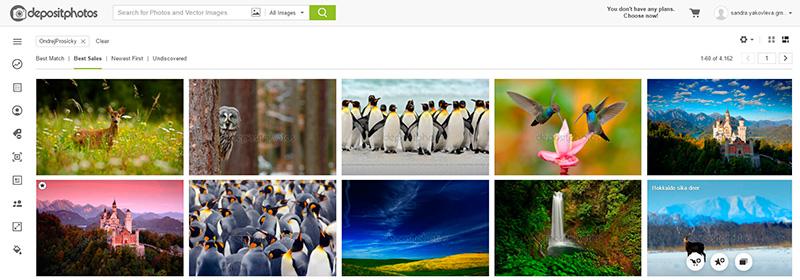7 Tips to Improve Your Photography Portfolio and Increase Sales
In the course of years, we’ve covered a lot of grounds on our blog. We talked about stock photography topics that are in demand, photography projects you could take on, and general tips for professional and beginner photographers that we think would be useful. Today we’ll look over all the articles that will collectively help you improve your body of work and ultimately drive up the sales from your stock photography portfolio.
Stock photography isn’t an easy business to break into. When competition is high, you’ve got to do something different. You need to stand out in a way that will distinguish your photography portfolio from hundreds of others and that’s what we’ll focus on. How do you improve your portfolio today to reach more clients?
This article also includes the online portfolios of some of our top contributors. To see examples of their works, simply click on the images or see our collection of interviews.
1. Learn to edit and cut down
The most common mistake is to upload a ton of images while treating photography portfolio websites and stock photography platform portfolios the same way. It’s a common misconception that a bigger photography portfolio will make you more money. In short, that is true, you do increase your chances. However, it’s much more productive to spend time keywording and editing your photographs. This quality check will ensure that you make more sales.
Learn to edit and do it in your personal style. Not every single image you take should make it to your photography portfolio. With a good editing eye, you’re improving the quality of your work which in turn says a lot about your professionalism. Imagine you had to make a print portfolio to present to clients – I bet 80% of your photographs won’t make the cut if you had to make that decision.
Improve portfolio and increase sales in 2020. It’s not a secret that the number of contributors constantly grows. Explore what they offer and try to create an online portfolio using images that are significantly different from everything else. Make your portfolio memorable. The visual trends guide by Depositphotos will help you with that.
2. Think in series, not shots
It goes without saying that every photography portfolio has shots and series in the style of the individual photographer. Combined with the previous point, you’ve got to edit your series of photographs to perfection. If you do have a series of photographs, make sure they are versatile as opposed to identical shots at slightly different angles.
Taking food photography as an example, don’t just settle for an image of a finished dish. As beautiful as it might be, make the most of the whole process – photograph the raw ingredients, the steps to making the dish and the final outcome. With this approach, and given you’re organized, you increase your chances of selling more than one photograph if clients stumble on your series.
Improve portfolio and increase sales in 2020. What series are the most demanded this year? Do not try to imitate series based on images that you’ve already seen on advertising posters and banners. Create your unique visual narrative. As a starting point for the series, take a topic you are experienced on. Among the most sought-after stories from the beginning of 2020, you will find work from home, slow living, and healthcare.
3. Don’t be afraid to break the rules
Every photographer has a preconceived attitude towards stock photography. Some think it’s just generic shots with burned lighting and cliched representations of basic concepts. Get out of this mindset and develop your own approach to stock photography. There aren’t any rules in stock photography except for images of impeccable quality.
Break the rules twofold. First of all, understand that if you have to shoot a popular concept, the images you see online aren’t the only interpretation. Show your own take on new concepts like we’ve done with our project Reinventing Stock Photography. And secondly, break the conventional rules of photography – use some shots from your personal portfolio and upload them to stock photography platforms to show something different and unique. This is where your personal style shines through. It is this unique signature that will guide you to more sales if your images stand out in the search feed.
4. Create quality descriptions and keywords
A good way of approaching descriptions is to use the words you would normally use to find the image. Go easy on the adjectives. Place yourself in the shoes of the client and describe the image briefly to the best of your ability. Some photographers use long sentences to describe their work which doesn’t really help you get discovered. Less is more sometimes.
Keywording is the one focus that can drastically help you with stock photography sales. Never use unrelated words with the intention of getting more views while creating your online portfolio. This doesn’t work and actually worsens the overall user experience when clients search for things in our library. Focus on descriptive words and don’t get too conceptual as those descriptive words are used more rarely to search for images. For more information on keywording read our article ‘The Elephant in the Room: Keywording Images for Stocks’.
Improve portfolio and increase sales in 2020. Update your descriptions and keywords regularly keeping your eye on trends and what’s going on around the world. It may happen that some of your old images could now reflect modern topics and attitudes. As the context of brands and their customers is constantly changing, and the online aesthetics remain very flexible, your photography portfolio on stocks may well get a new influx of customers with keyword upgrades. Think about how customers will find your images.
5. Focus on your niche
Both newcomers and experienced photographers are constantly puzzled with the question of how to create a photography portfolio with images that will be in high demand. Popular advice from our top contributors is that you should (eventually) find your niche in stock photography and try to attract a target audience which needs and tastes you are familiar with. You can try really hard to put together a very versatile photography portfolio but eventually, it will come down to a specialty in your themes, topics, and personal style.
You already know that competition is fierce in stock photography. Your work needs to have some element of surprise or some signature touch in order to make significant sales. You learn this with time when you analyze which images sell. Always pay attention to those statistics and move in the direction of the demand without compromising your artistic vision.
You can always start with or eventually make your way to some of the unexplored themes in stock photography. There are also some sure ways to fill your online portfolio such as these stock photography themes that you can’t go wrong with.
Improve portfolio and increase sales in 2020. You can use your Instagram account to follow the changing interests of your target audience. A personal blog will help you keep in touch with potential buyers and learn their insights by asking them for feedback. In 2020, we also advise you to use social monitoring tools, which allow you to evaluate the trends with certain events or visuals.
6. Think like an entrepreneur
Your work doesn’t stop with the upload button. We’ve briefly gone over this in the article ‘10 Quick Marketing Tips for Photographers’. You have to consider other things such as your own website, a mailing list, a way to promote your online portfolio on other social media accounts, and other little things that actually accumulate to help you promote yourself.
When you enter the microstock business, you’re essentially running a side business or an actual business, depending on how invested you are in your work. Even if you don’t have a lot of time to devote to promoting yourself online, consider our quick tips to help you get started.
7. Pace yourself, keep everyone on their toes
The key to take away from this article is that a stock photography portfolio takes time and effort if you want to see returns. You have to establish some sort of a business model to reap the benefits. You have to put in steady effort and pay attention to details outside of just taking pictures. To really do this, you need to pace yourself.
Some photographers can contribute a couple of hundred images a year, others thousands. You have to find a level you’re comfortable with so focus on establishing a steady upload pace. If clients like your work, they’ll share or save it because you’re memorable. You build your reputation with time.
Lastly, stay just a few steps ahead of everyone else and keep them guessing. This element of surprise in your photography portfolio is a great strategy for starters. Find more tips on how to create an online portfolio from scratch in ‘The Complete Guide to Becoming a Depositphotos Contributor’.
Improve portfolio and increase sales in 2020. You can optimize your online portfolio working pace using real-time insights. If your target audience is online lifestyle magazines for women, keep in mind that their need for images is higher than the one of business magazines. The more often your customers need to produce content, the more often they can buy visuals from you. You can learn about their needs by checking their digital products and social media accounts. Knowing the needs of your audience will help you avoid overproduction.














